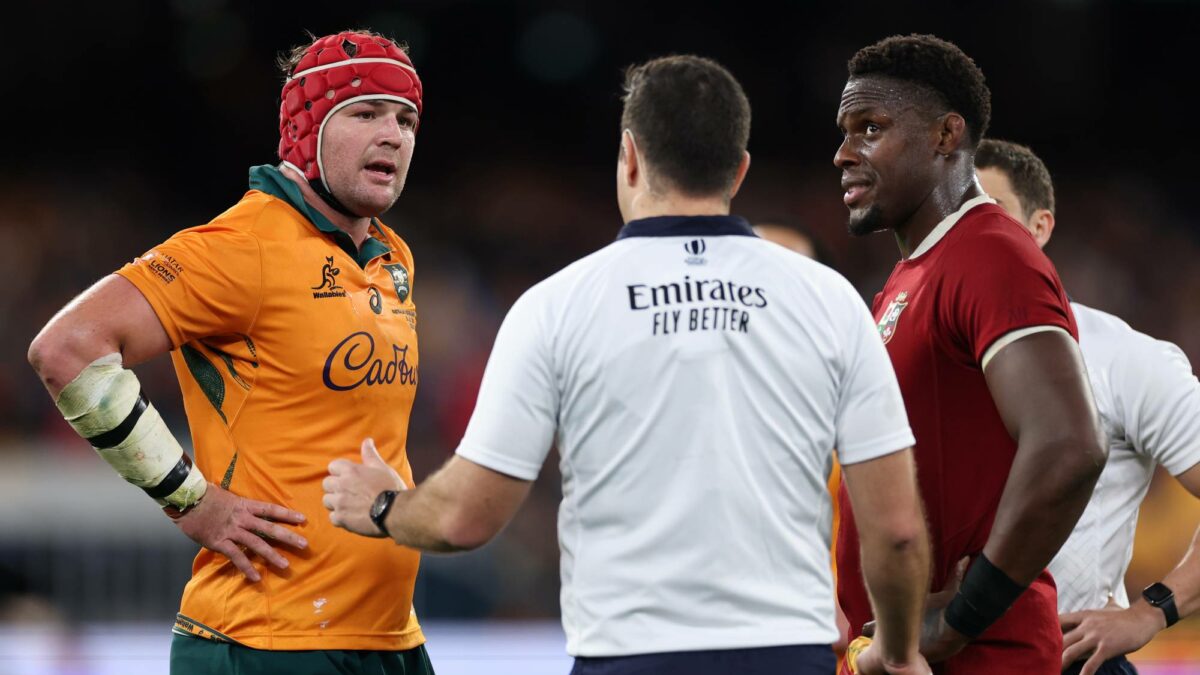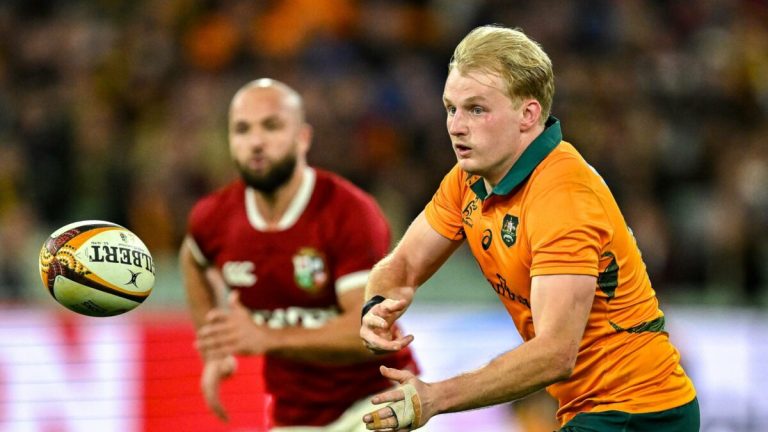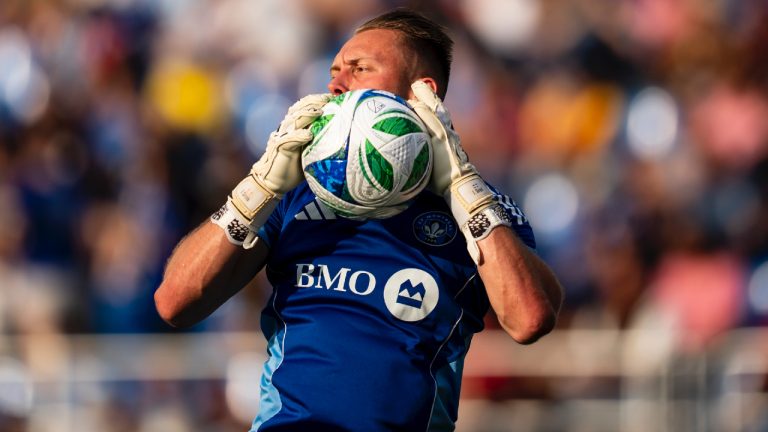Here is my bias: I am a Wallabies supporter and a lover of rugby, I’ve coached and managed junior teams, manned the BBQ and served on club committees. I watch more rugby than any other sport. I am not a referee, but I study the rules and I try to understand them. Often, I’ll call a mate who is an internationally accredited referee and ask him to clarify rules and their differing interpretations.
Since the second Test, it seems that most Northern Hemisphere commentators have not bothered to declare their own bias, perhaps unaware of their delusion, and the hypocrisy of their declarations about typical whingeing, cheating Aussies. Please, Bodyline, anyone?
Scraping the bottom of their already limited arsenal, the North has clung to / trotted out “what aboutisms”, regarding lucky calls in the recent Fiji Test and the 2015 World Cup game against Scotland. Two points on that; 1) neither involved foul play, and 2) Even a reasonably lazy scan of the Australian press or quick canvassing of the Australian public would reveal that in both circumstances we acknowledge now as well as at the time, that we were very lucky to receive the benefit of the referee’s call and subsequently get away with the win.
With that said, let’s talk about the rhino in the room, two rhinos in fact.

Will Skelton of Australia speaks to referee Andrea Piardi of Italy during the second test of the series between Australia Wallabies and British & Irish Lions at the Melbourne Cricket Ground on July 26, 2025 in Melbourne, Australia. (Photo by David Rogers/Getty Images)
The first rhino is that try, the Superman try, that was thankfully Superman and not Christopher Reeves. Whilst it is legal to dive in the act of scoring a try, it is illegal to dive over a tackle. The avoidance of a tackle came prior to the player being in a position to score a try and a penalty should have been awarded.
The second rhino is of course that clean-out. It is the most topical due to its proximity to the death of the match and much vitriol has been sprayed about by our visitors’ fans near and far ever since. They’re unhappy that Jac Morgan’s perfect technique had been questioned – and so they sought to tar all Australians as whingers and Carlo Tizzano as a cheating (albeit poor) actor.
Now we’ve heard Nigel Owens thinks the call was okay, and Wayne Barnes said it was all close to perfect. Imagine, a Welshman and an Englishman who are former referees commenting on the decision made by a referee colleague relating to an act committed by a Welshman that favoured the British and Irish Lions, finding no issue with it. Are we marking our own homework?
Since then, we’ve heard from another Brit, the CEO of World Rugby, Alan Gilpin. His grand contribution to clarity was to admonish Joe Schmidt (for having the temerity to refer to the rules) then saying Joe had remained respectful and would not be punished (for what exactly?) then adding that they’ve analysed the incident and made their findings available to the teams but that they won’t release them to the public.
There is nothing quite as opaque as the transparency of someone trying very hard to avoid the uncomfortable truth.
Wayne Barnes’ additional contribution that “every time there is head contact, it does not mean that there is foul play” is curious, perhaps he’ll check in with Sam Cane and explain how he applies this thought bubble in real life.

Sam Cane of New Zealand walks past the The Webb Ellis Cup following the Rugby World Cup Final match between New Zealand and South Africa at Stade de France on October 28, 2023 in Paris, France. (Photo by David Ramos – World Rugby/World Rugby via Getty Images)
We’ve also heard from a variety of former players in disgraceful terms about Tizzano’s supposed character flaws, James Haskell is the chief offender. Imagine saying, “The only bit of foul play and nonsense in that incident was the Australian player diving. THAT should be red-carded.”
To judge the reaction of a player from the safety of your sideline commentary booth is a particular kind of gutless. We play the game for the physicality of the contest; we are inspired by dynamic, fearless athletes, no sane person can really be happy to endorse high and reckless contact. We’ve heard now from Schmidt that Tizanno’s impact-detecting mouthguard recorded almost twice the level of force from this clean-out as compared to a usual breakdown incident. Perhaps Haskell might apologise for the unsporting smear.
There is a tendency to judge foul play by the outcome, not the action. That is the wrong test to apply; foul play doesn’t always result in injury in the same way that drink driving doesn’t always lead to a fatality.
However, if and when foul play does cause harm, the injury can be catastrophic. Therefore, actions that increase the risk of catastrophic outcomes must be policed in the same way we police any dangerous action in society.
So, let’s take a deep breath and analyse the facts as dispassionately as we can and apply the rules to them.
I think law 9.20 (b) is very clear. It says in relation to “Dangerous play in a ruck or maul” that a player must not make contact with an opponent above the line of the shoulders. The sanction is a penalty.
Any reasonable person would conclude after viewing the footage in slow motion or real time that the contact is made above the shoulder line. Evidence includes the clear visibility of the Santos logo on the Wallabies jersey. If contact was below the shoulder line, it would not be visible.
The mitigation that the players arrived at the same time doesn’t hold up under any level of scrutiny, so I am curious to understand how the conclusion was reached so quickly. From the footage, it can be observed that Morgan doesn’t wrap (his left hand is on the ground) and he enters with a downward motion coming from high to low, the opposite of textbook and increasing the probability that he will leave his feet and seal off the ball (which he does).
The sanction of that combination should be a penalty as well. If there was any attempt to wrap it was grabbing Tizzano by the ankle after he’d been ejected from the ruck, perhaps that was tackling a player without the ball, the sanction again would be a penalty.
Much has been made of two other items: Tizzano’s entry to the ruck (although none had been formed as he was the first to arrive) and his head being below his hips.

MELBOURNE, AUSTRALIA – JULY 26: Carlo Tizzano of the Wallabies receives medical attention following a contest in the final moments of the second test of the series between Australia Wallabies and British & Irish Lions at the Melbourne Cricket Ground on July 26, 2025 in Melbourne, Australia. (Photo by Morgan Hancock/Getty Images)
On viewing the footage, it appears that Tizzano’s head is above his hips or they are level until Morgan hits him in the back of the neck. It appears that Tizzano is making a fair jackal and is entitled to the referee’s protection. However, even if you don’t accept these observations (that Tizzano entered correctly, that his head and hips were correct and that he was making a fair jackal) then it doesn’t matter. Why? Because Morgan had hit Tizzano above the neckline, foul play, sanction penalty.
Then there is the useless observation from some pundits along the lines of what else is Morgan supposed to do? That is the point, it is very hard to legally stop a player in a strong jackal position. What was Morgan meant to do? Slow down, maintain his feet and try to remove Tizzano, legally! Tizzano’s superior speed and body position don’t create an excuse for foul play.
I don’t envy rugby coaches anywhere this week; they need to explain to players, young and old, why flying into a ruck off your feet or hitting a player high is not acceptable. They need to talk to young players about why Superman dives over rucks are not a good idea.
They need to do this because a group of elite referees made some errors, and World Rugby decided that they don’t need to clarify any of this. Strangely, they preferred to divert by admonishing Schmidt rather than seize a golden opportunity to reinforce their commitment to player safety and ensure on-field decisions are consistent with that objective.
Finally, a subtle message to all the Brits visiting, enough of the whingeing Aussies rot, just say thank you for the cold beer, scenic beaches and pleasant winter climate.
Despite rugby being only our third or fourth winter code, despite our smaller population, despite the fact we have literal alternative Wallaby teams playing professionally in Europe (some of the players are even in your squad), we still have twice as many world cups as you lot combined (and we aren’t even the best performing nation in the Southern hemisphere). We acknowledge that the Lions staged the mother of all comebacks, so compelling that I think there was a chance we still would have managed to lose even if the final decision went our way.
We didn’t get the win, we’ll find other ways to rebuild and revitalise the game here, and there is the nucleus of a seriously good team building, the heartbeat is strong. Perhaps that’s what you’re afraid of.






